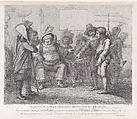Falstaff at Justice Shallow's Mustering His Recruits (Shakespeare, Henry IV, Part II, Act 3, Scene 2)
Not on view
Bunbury's "Shakespeare" consisted of twenty-prints published between 1792 and 1797, issued periodically in sets of four. The publisher Thomas Macklin was inspired by the success of Boydell's Shakespeare Gallery to open a rival Poets Gallery in 1787. He then commissioned a set of large watercolors from Bunbury of comic Shakesperean subjects with related prints issued by subscription. The artist was the younger son in an old gentry family who had amused fellow students with comic drawings at Westminster School in London, then at Cambridge University. He became a friend of Thomas Rowlandson, who etched many Bunbury designs. Most of Bunbury's income came, however, from army positions and the patronage of the Duke of York, whom he served as equerry. The Shakespeare series of watercolors rank among the artist's most ambitious and soon belonged to the Duchess of York. William Nelson Gardiner, a follower of Francesco Bartolozzi, produced this stipple engraving of a scene in "Henry IV, Part II" in which Falstaff recruits rustic tradesmen to fight in France. The demeanor of Feeble, a woman's tailor, indicates that he is unsuited to soldiering.
Due to rights restrictions, this image cannot be enlarged, viewed at full screen, or downloaded.



